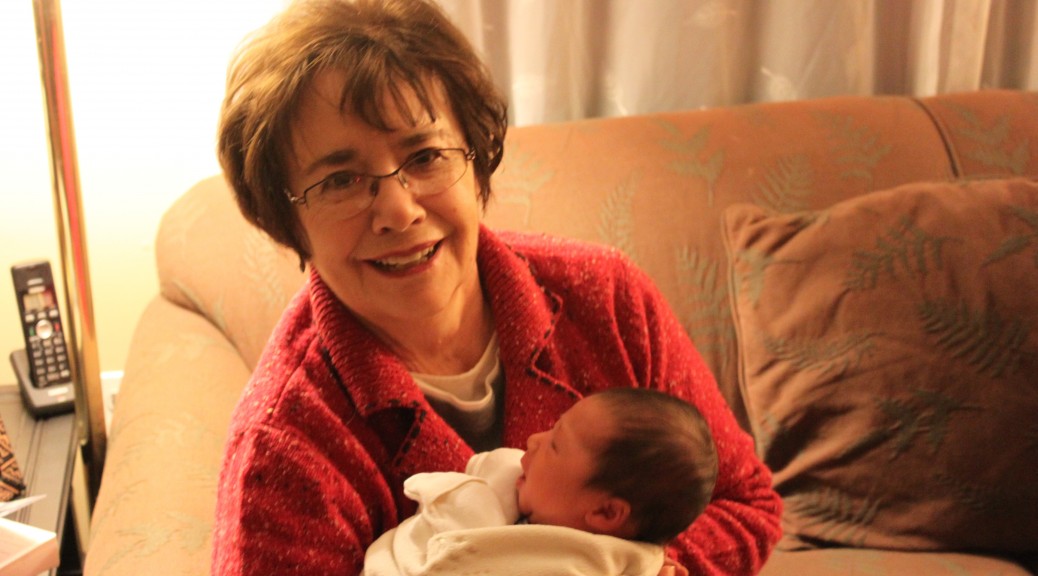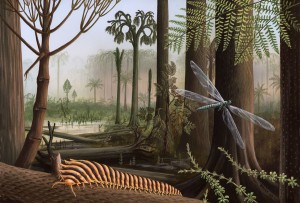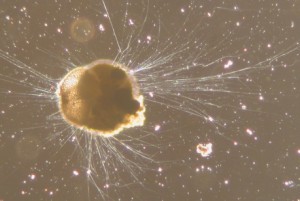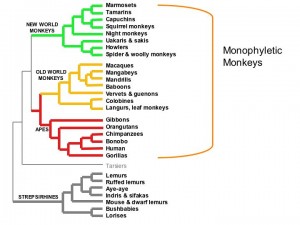As George Carlin says, “It’s inevitable when you buy the pet. You’re supposed to know it in the pet shop. It’s going to end badly. You’re purchasing a small tragedy.”
The same goes for studying animal behavior. Anyone who spends enough time in the field, getting to know the lives of animals, will also witness their deaths. In a new paper, “Pathologic lesions in chimpanzees (Pan troglodytes schweinfurthii) from Gombe National Park, Tanzania, 2004-2010,” we report on some of the things we’ve learned from chimpanzees who have died. This paper, led by Karen Terio at the University of Illinois, involved a large team of field researchers, veterinarians, and pathologists.
I started studying chimpanzees because I was interested in how they lived. But in studying their lives, I’ve seen many of their lives come to an end. In this way, studying chimpanzees is a bit like being an Elf in J. R. R. Tolkien’s Middle Earth. In Tolkien’s world, the Elves live for centuries, dying only if they encounter some mishap, such as being slain in battle. In a single life, an Elf such as Elrond watches sadly as generations of mortal men come and go. In a similar manner the generations of chimpanzees, though long by the standards of typical mammals, pass more quickly than those of our own species. Jane Goodall, who has been watching chimpanzees at Gombe since 1960, has seen entire generations come and go. Chimpanzees that Jane saw as newborn babies have grown old and died, and their children, grandchildren, and now great-grandchildren have been born. I’ve only been working at Gombe since 2001, but this is still long enough that many of the chimpanzees I’ve gotten to know there have since passed on: Fifi, Goblin, Vincent, Ebony, Andromeda, Patti, Ebony, Sherehe, Shangaa, Echo, Yolanda, Malaika, Kris, and others.
I knew each of the 11 chimpanzees we describe in this new paper, except for a stillborn baby. I was involved in various ways with documenting the ends of their lives, such as taking observations during their final days, helping with the recovery of their bodies after death, examining the bodies immediately after death, organizing and participating in the necropsies, burying the bodies and recovering their skeletons from their graves, after they had been buried for at least a year. My student Claire Kirchhoff examined these skeletons for evidence of trauma.
Determining the cause of death is important for many reasons, including understanding chimpanzee life histories and identifying threats to their conservation. Because my research focuses on aggression, it’s especially important for me to know the cause of death. Did they die from aggression, or some other cause? In each case, it’s important to document carefully the relevant evidence.
Graucho Marx said, “Outside of a dog, a book is man’s best friend. Inside of a dog, it’s too dark to read.”
I’ve never tried reading inside a dog, but I’ve ended up sending more time looking at the insides of chimpanzees than I ever expected. If I had known what the future held for me, I would have taken some proper anatomy courses. But fortunately at Gombe, we’ve benefited from a wide range of expertise, including the Health Monitoring Project led by Elizabeth Lonsdorf and Dominic Travis, and the virology study led by Beatrice Hahn. We’ve been able to store chimpanzee bodies in large freezers until we can assemble teams of experts to conduct necropsies. We send tissue samples to pathologists and molecular virologists to gain a finer grained understanding of the causes of death.
I study violence in chimpanzees, not because I like violence (I don’t), but because it plays such an important role in the lives of chimpanzees – and as one of the two species most closely related to humans, chimpanzee violence can help us understand violence in our own species. Chimpanzee violence caused 36% of deaths in this study – more than any other factor. Andromeda and Patti were killed during intergroup attacks. Vincent was killed by members of his own community. Ebony – found dead with a broken neck and puncture wounds – almost certainly killed by chimpanzees, and likely one or more of the males of his own community.
One of the humbling things about research is that often, even with all the expertise we can muster, there is much that we will never know for sure. One such case involves the adult female Echo, who became a long-term resident at Kasekela at about the same time that I did. I caught my first glimpse of Echo during one of my first days in the field as Director of Field Research at Gombe, back in January 2004. While we were watching a large group of chimpanzees feeding in the trees above a steep valley, videographer Bill Wallauer pointed out a new immigrant female chimpanzee with a pretty face and an asymmetric, bumpy sexual swelling. Bill recognized her from pictures he had taken in 1999, and thought she might be a female seen during an intergroup encounter in 2003. We named her Echo because she seemed to keep bouncing back. Unusually, Echo had immigrated together with her juvenile daughter, who we named Eowyn, after the heroic shieldmaiden from Tolkien’s Lord of the Rings.

Usually, females only move from one community to another as adolescents, before they have children. Infants of immigrants face a high risk of being killed by the resident males, as nursing infants fathered by other males represent both genetic competition and an unwelcome form of contraception. But Echo chose a good time to immigrate: her daughter Eowyn was weaned, and Echo had a full sexual swelling. The Kasekela males left Eowyn alone, and Echo quickly conceived a daughter, Emela.
Genetic analysis of fecal samples confirmed that Echo used to live in the Kalande community. Her departure from Kalande showed just how bad the decline of that community had gotten. Usually, once females have settled into a community and have started having babies, they stay there for life. But females seem to prefer living in a community with multiple males, which may be important both to protect them from intergroup aggression and to provide them with some good options for mates. Echo left when the number of adult males in Kalande dropped to one.
We also learned that Echo was infected with SIVcpz, the virus that is the immediate precursor of HIV-1, which causes AIDS in humans. Four of the 11 chimpanzees in the new study were infected with this virus. Until recently, it was widely assumed that SIVcpz was harmless in chimpanzees. We learned from studying Gombe chimpanzees, though, that infection with this disease greatly increases mortality risk. Two of the chimpanzees in this study died from AIDS-like symptoms.
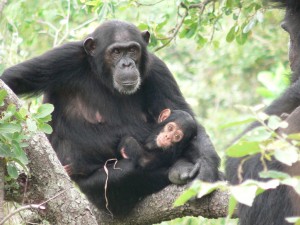
I particularly remember Echo from a day in March 2006. In the late afternoon, the chimpanzees climbed high into a hill above Kasekela valley, into an open woodland. They climbed into the short, stunted trees to feed, rest and groom. Echo climbed rested on a low limb and groomed with Tubi, Bahati and her son Baroza. All seemed peaceful and happy. Echo had immigrated successfully, settled into Kasekela, had a daughter, and made friends.
But this was not to last.

In November 2006, which happened to be my last month of being based full time at Gombe, field assistants monitoring the Kalande community reported that one of their females, Patina, was sick. Together with vet Iddi Lipende, I traveled down to Kalande to investigate. We found a female chimpanzee lying in a dry streambed, her legs apparently paralyzed. She looked at us fearfully. She was too weak even to shoo away the flies that gathered at the wounds she had inflicted on herself, dragging her broken body along the stones of the dry streambed. She died within a few days.
In the following months, analysis of genetic samples found something puzzling: new fecal samples continued to come in from a female who was an exact genetic match for Patina. Apparently it wasn’t Patina who lay dying in that streambed – it was someone else. Given that the Kalande chimpanzees aren’t habituated, a case of mistaken identity was not so surprising. But the puzzle remained: who was the female who died?
Around this time, Echo’s daughter Eowyn showed up in Kasekela without her mother – something unusual for such a young chimpanzee. And genetic analysis of the tissue from the dead female found that she was, in fact, Echo. She had gone back to her home community of Kalande and died there. In her weakened state, she looked so different that none of us had recognized her. Her infant Emela had disappeared and must have died as well.
The necropsy found that Echo had a broken spine, but we don’t know how she broke it. She didn’t have the other injuries typical of a chimp attack – no canine puncture wounds, missing fingers or toes – so it seems unlikely that chimpanzees had killed her. Did she fall from a tree? If so, why? Was she chased by other chimps? Or did she just have bad luck? We will never know.
Here are the publications where we report some of the findings discussed here:
Keele, B. F., J. H. Jones, K. A. Terio, J. D. Estes, R. S. Rudicell, M. L. Wilson, Y. Li, G. H. Learn, T. M. Beasley, J. Schumacher-Stankey, E. E. Wroblewski, A. Mosser, J. Raphael, S. Kamenya, E. V. Lonsdorf, D. A. Travis, T. Mlengeya, M. J. Kinsel, J. G. Else, G. Silvestri, J. Goodall, P. M. Sharp, G. M. Shaw, A. Pusey, E. and B. H. Hahn (2009). “Increased mortality and AIDS-like immunopathology in wild chimpanzees infected with SIVcpz.” Nature 460: 515-519.
Rudicell, R. S., J. H. Jones, E. E. Wroblewski, L. G. H., Y. Li, J. Robertson, E. Greengrass, F. Grossmann, S. Kamenya, L. Pintea, D. C. Mjungu, E. V. Lonsdorf, A. Mosser, C. Lehman, D. A. Collins, B. F. Keele, J. Goodall, B. H. Hahn, A. E. Pusey and M. L. Wilson (2010). “Impact of Simian Immunodeficiency Virus Infection on chimpanzee population dynamics.” PLoS Pathogens 6(9): e1001116.
Terio, K. A., M. J. Kinsel, J. Raphael, T. Mlengeya, I. Lipende, C. Kirchhoff, B. Gilagiza, M. L. Wilson, S. Kamenya, J. D. Estes, B. F. Keele, R. S. Rudicell, W. Liu, S. Patton, D. A. Collins, B. H. Hahn, D. A. Travis and E. V. Lonsdorf (2011). “Pathological lesions in chimpanzees (Pan troglodytes schweinfurthii) from Gombe National Park, Tanzania, 2004-2010.” Journal of Zoo and Wildlife Medicine 42(4): 597-607.





